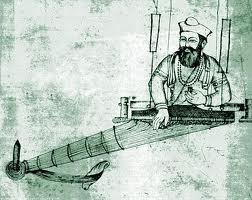The problem of bullying in schools and work place environment has become such a menacing issue that the concerned states and the school authorities are looking at ways of combating it. The impact on the bullied is quite devastating with the strongest turning into shrinking violets. Although; the recognition of the menace of bullying is a relatively recent phenomenon, its existence dates back in times. Bullying can take various forms as verbal abuse, threat, intimidation, teasing, physical assault, and unduly hard criticism are major recognized forms of bullying. Now with the newer technologies as email, Facebook, videos, and digital pictures have opened up new vistas to the existing challenge.
Now let us look at Kabir's own words and see how he handles the societal bullying and successfully deflects the scorn that he subjected to with his higher wisdom and understanding. He does not get mad, depressed, or rankled by the heaped contempt, but offers a new perspective for all. This is a very interesting shabad (poem) by Kabir Ji offering insights for us. Kabir, belonged to the weaver caste community was therefore considered as a low caste, and thus was subjected to taunts and ridicule at the hands of Brahmins, wealthy, and other people of higher classes. Imagine being a low caste in those days and the living in Banaras; the holiest city of the Hindus where the writ of high caste Brahmins ran unchallenged must have been difficult.
However, in case of Kabir there was a cause of added contempt, as with his devotional practices he had gained respectability in the society thus he was iconic symbol of the low caste community to be putdown as a message to the rest of community. As a part of putdown these weaver class people were called Kori or Jhulaha which means weaver of new clothes. Well the word Kori is related to the word kora; which in the Indian languages means new cloth. Thus Kori means a person who weaves and makes new cloth. The people who wash and cleaned the dirty clothes were called Dhobi.
Interestingly here Kabir is using that same term for the God the Creator, and says that he has woven a textile which is the entire creation. Let us see how he counters the bullies by his response:
 "korI ko kwhU mrmu n jwnW ] sBu jgu Awin qnwieE qwnW ]1] rhwau ]"
"korI ko kwhU mrmu n jwnW ] sBu jgu Awin qnwieE qwnW ]1] rhwau ]"
"Kori ko kaahoo maram n jaanaa. Sabh jag aan tanaaeiou taanaa.1. Rahaao." (SGGS, Pg. No. 484)
Meaning: No one knows the secret of God, the Cosmic Weaver. He has stretched out the fabric wrap of the whole universe. 1.Pause.
Kabir compares the created universe to a textile which the Creator has created on His divine loom. In subsequent lines he further elaborates on the theme of the Creator being Kori. Addressing his bullies he counter them as:
"jb qum suin ly byd purwnW ] qb hm ieqnku psirE qwnW ]1]"
"Jab tum sun lae baedh puraanaa. Tab ham eithanak pasariou taanaa."
Meaning: While you were listening to the Vedas and the Puraanas, during the same period I have woven this small piece of fabric.
Kabir is saying while you were engaged in the ritual practices, during the same time I was engaged in this activity of weaving to earn my livelihood. But in the process of weaving a small piece of textile, I have figured that textile of Universe has been woven by God. This is quite a revealing and a bold declaration. For most of work is work as it provides us with livelihood; but for him work was worship and an activity that took him in a flow and it became a divine revelation. Kabir further elaborates how the Creator has created the textile of the universe.
"Drin Akws kI krgh bnweI ]cMdu sUrju duie swQ clweI ]2]"
"Dhharan akaas kee karageh banaaee. Chandh suraj doae saathh chalaaee."
Meaning: He has fashioned His loom out of earth and sky. Upon it, He moves the twin shuttles of the sun and the moon.
Here Kabir in the process of describing how the Master Weaver stretched out the fabric of Universe, he has juxtapositioned his work experience of weaving in the context of creation of the universe. He shares with us that the Creator is intertwined in the creation like the yarn is in the fabric. He also describes that the Sun and Moon are twin shuttles that keep the creation engaged in work during the day and at rest at night.
"pweI joir bwq iek kInI qh qWqI mnu mwnW ] jolwhy Gru Apnw cIn@W Gt hI rwmu pCwnW ]3]"
"Paaee jor baat eik keenee teh taantee man maanaa. Jolaahae ghar apanaa cheenaa ghatt hee raam pachaanaa."
Meaning: Placing my feet on the pair of treadles, I have accomplished one thing - my mind is pleased with that Weaver. I have come to understand my own home, and recognize the Lord within my heart.
Again, Kabir is sharing his deep understanding that came with his working in tandem on the pair of treadles of the loom. He says that the Great Creator also uses twin treadles of life and death to constantly weave a new and ever changing universe. The understanding that he developed is that the all-pervasive Creator can be experienced within and this resulted in his having a complete faith in the Creator. Kabir concludes with the following words:
"khqu kbIru kwrgh qorI ] sUqY sUq imlwey korI ]4]3]36]"
"Kehat kabir kaarageh toree.Soothai sooth milaaeae kori."
Meaning: Says Kabir that the Kori (Creator) smashed the loom, and then thread (my soul) blends with His thread (Universal soul).
Here Kabir is talking about merger of his soul with the universal soul. His worldly attachment (metaphor of loom) has been broken and the result is that his soul is merged with soul of the Creator. Thus, although people call him Kori with the intention of looking down and putting him down, but they do not know who the real Kori is? He declares that God is the real Kori and he, Kabir has become one with Him. Now this is the ultimate achievement and with this achievement no amount of bullying can affect the bullied. What the bullied Kabir is saying back in response is not mere empty boasting, but has a sense of fulfillment at his achievement. This is a brave and strategic response to efforts of downsizing him because of his caste and profession. This teaches us how to handle ourselves in such a situation when one is bullied. He is standing tall because of his achievement in life and that has made him brave to face the taunts, and not get victimized.
This shabad thus holds twin lessons for us; one that of purpose and achievement in life and second lesson is how to conduct ourselves when being subjected to bullying. The first lesson is spiritual achievement and second lesson is very pertinent to our worldly life. Just last year there were over 13 million kids bullied. There is no record of bullying in the adult world either at work place, homes or in the communities but it does exist. The bullying is not always physical but the scars of bullying could be mental and psychological. Because the subject has grave repercussions that the film director Lee Hirsh captured it in a movie titled Bully. In this film the story focuses on five youth who were bullied, including two who committed suicide, and how their families, school and communities coped with and responded. The governments are setting national bullying centers with help lines for those subjected to bullying. But if we take lesson from the experience of Kabir this problem can be addressed by an individual in a proactive and satisfactory manner.
References:
1. Singh, Bhai Vir. Santhya Sri Guru Granth Sahib. Volume 4.
2. Singh, Prof. Sahib. Sri Guru Granth Sahib Darpan. Volume 3.
3. Singh, Amir. Sampradaaee Sateek. Volume 4.
4. Dharwadkar, Vinay. Kabir The Weaver's Songs
5. www.sadhsangat.com
6. www.sikhitothemax.com

